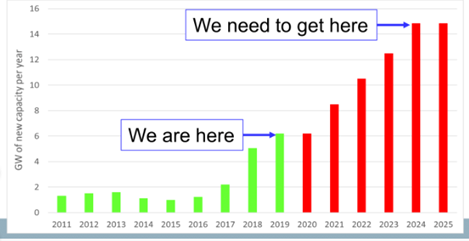Ok folks its time to talk about overbuilding renewable energy as the quickest and cheapest way to a low-carbon future for Australia.
THREAD https://twitter.com/adamlmorton/status/1246199614002188288">https://twitter.com/adamlmort...
THREAD https://twitter.com/adamlmorton/status/1246199614002188288">https://twitter.com/adamlmort...
Firstly if you& #39;re thinking about both the economic recovery from the #Covid_19australia crisis and how to respond to the #climatecrisis, I highly recommend the excellent work of @Anna_Skarbek& #39;s team @ClimateWorksAus in their latest report. See @adamlmorton& #39;s article for summary
The analysis by @ClimateWorksAus "suggests over-building renewable energy to 200% capacity – double what the country needs – could be more cost-effective than building to 100%, and would spark new clean export opportunities."
Now it depends what you use as your baseline here. And it seems that @ClimateWorksAus is using 100% renewable energy to mean the renewable energy to decarbonise the majority of Australia& #39;s energy use - electricity, transport, heating, industry.
I haven& #39;t yet gone through the @ClimateWorksAus report in detail, but I wanted to share some figures that we& #39;ve been working on at WWF Australia in terms of renewable build needed...
In October 2019, @darrenhmiller from ARENA suggested if we want to have a renewable export industry the size of our LNG industry we would need to be building 700% renewables (wind & solar). But what does that mean?
There are about 10 100% renewable scenarios for Australia out there, the majority (though not all) of these suggest we need in the order of 90-100GWs of renewables and storage to decarbnonise Australia& #39;s existing electricity system.
Then if we want to decarbonise our transport, industry and heating sectors in Australia we need to be building an extra 200GWs (UTS study that I was involved in) to 300GWs (analysis by Andrew Blakers at ANU) of renewables.
That takes us to 300-400% renewables, if you use our current electricity demand as the basis for 100% renewables (which isn& #39;t what Climate Works does, but that& #39;s fine - just different methodologies).
Then in a 700% #renewables scenario that would leave 300-400GWs to export renewables in the form of renewable hydrogen, cables to SE Asia or renewable electricity embodied in goods such as green steel, other refined minerals, advanced manufacturing etc.
So that& #39;s the vision - at the least 300% renewables and we could go to 700% renewables or beyond if we want to maximise the economic opportunity of our abundant renewable resources and large land area.
But what does that actually mean in practice?
In 2019 we built ~6GWs of wind and solar. If we want to get to 100% renewables by the early 2030 (quicker than Climate Works suggests is needed but in line with what @BillHareClimate and Climate Analytics suggest is needed)...
In 2019 we built ~6GWs of wind and solar. If we want to get to 100% renewables by the early 2030 (quicker than Climate Works suggests is needed but in line with what @BillHareClimate and Climate Analytics suggest is needed)...
... we need to keep building 6GWs per year for the next decade, with about 10-25% storage/flexible demand.
If we want to go to 300-400% renewables by 2050 & accelerate the renewable electrification of transport and industry Andrew Blakers at ANU suggests we need 15GWs/year of RE
If we want to go to 300-400% renewables by 2050 & accelerate the renewable electrification of transport and industry Andrew Blakers at ANU suggests we need 15GWs/year of RE
But the @AEMO_Media Integrated System Plan& #39;s most ambitious energy transition scenario only has us building 47GWs of renewables by 2040 or 2.35GWs/year.
A lot less than what some leading academics say is needed and a LOT less than is needed to create a renewable export industry
A lot less than what some leading academics say is needed and a LOT less than is needed to create a renewable export industry
However, as we all know the renewables industry is currently in a downturn due to transmission issues and a lack of policy. The best way to address this is to accelerate the deployment of transmission right now!
However, recently I& #39;ve heard progressive and climate savvy insiders suggest that the downturn in demand as a result of the COVID19 crisis is a reason not to invest in transmission. This is confounding to me, particularly given a) how long it takes to build transmission...
b) how much the lack of transmission is holding back the renewables build and
c) how important building more transmission is to decarbonising other sectors of the economy and unlocking renewable exports.
c) how important building more transmission is to decarbonising other sectors of the economy and unlocking renewable exports.
One argument I am hearing is that now is the time to seize the opportunity for energy productivity and efficiency measures - I am all for this. To my mind they are not mutually exclusive - we need both.
So my question to #energytwitter friends - are the organisations you are involved in/advising just thinking about renewables and efficiency for the current electricity sector - or have you clocked the opportunity and imperative to go bigger? If not, what do you need to do this?
One final point before I end my rant - I heard today from a reliable source that the Netherlands is planning to overbuild their renewable electricity capacity to 400%. We are not alone in this thinking - but our renewable resources are better.

 Read on Twitter
Read on Twitter


